Archived Fire Damage Blog Posts
A Simple Guide to Choosing the Right Fire Restoration Partner
4/9/2024 (Permalink)
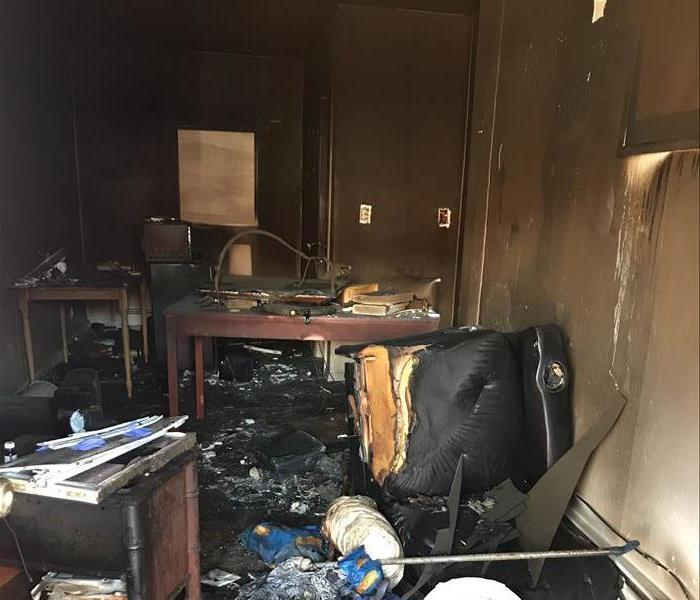 Choosing a reputable fire restoration company is a crucial step in the recovery process after a fire.
Choosing a reputable fire restoration company is a crucial step in the recovery process after a fire.
When faced with the aftermath of a fire, selecting the right restoration company is a crucial decision that can significantly impact the recovery process. In this guide, we'll walk you through practical steps to help you choose a reputable fire restoration company, ensuring a smooth and effective restoration journey.
Certification Matters
Begin your search by checking for certifications. A reputable fire restoration company should hold certifications from recognized organizations like the IICRC (Institute of Inspection, Cleaning and Restoration Certification). These certifications guarantee that the technicians are trained to industry standards, providing you with the assurance that your restoration is in capable hands.
Immediate Response Time
Time is of the essence in fire restoration. Look for a company that emphasizes a quick and responsive approach. A company with a 24/7 emergency line and a commitment to immediate response can prevent further damage and kick-start the restoration process promptly.
Comprehensive Services
Choose a company that offers a range of restoration services. Fire damage often involves various challenges, from structural issues and water damage to smoke and odor removal. A one-stop shop for comprehensive restoration ensures that all aspects of the damage are addressed efficiently, saving you time and effort.
Local Reputation
Investigate the company's local reputation by checking online reviews and testimonials. A solid track record in your community speaks volumes about the quality of their service. Look for feedback on their professionalism, response time, and the effectiveness of their restoration work.
Clear Communication
Effective communication is key during the restoration process. Choose a company that communicates clearly and transparently. They should be able to explain the restoration plan, provide detailed estimates, and keep you informed about the progress of the work. Clear communication fosters trust and ensures that you are on the same page throughout the restoration journey.
Proper Licensing and Insurance
Ensure that the restoration company is properly licensed and carries adequate insurance. This not only safeguards your property but also protects you from potential liabilities. Ask for proof of insurance and licensing to guarantee that you are working with a legitimate and responsible service provider.
Selecting a reputable fire restoration company is a crucial step in the recovery process after a fire. By considering factors such as certifications, prompt response time, comprehensive services, local reputation, clear communication, and proper licensing, you can make an informed decision that sets the foundation for a successful restoration. Remember, the right restoration partner not only brings your property back to life but also provides the support and expertise needed during a challenging time.
The Distinct Differences: Fire Damage Restoration vs Smoke Damage Restoration
11/15/2023 (Permalink)
When a fire ravages your home or business, the process of restoring it to its preloss condition can be overwhelming. With damage ranging from the actual flames to smoke and soot, the restoration process is a bit more complicated than just cleaning up the ashes.
Fire damage restoration is the process of restoring a property back to its pre-fire condition. This includes repairing walls, floors, and ceilings that may have been damaged by flames and soot. Smoke damage restoration focuses on removing the smoke odor and traces of soot that comes from the smoke.
Here are some key differences between fire damage restoration and smoke damage restoration:
- Cause of Damage - Fire damage restoration and smoke damage restoration both involve cleaning and repairing property damage. However, fire damage is caused by actual flames that can destroy structures and belongings, while smoke damage is caused by the smoke produced by the fire.
- Type of Damage - Fire damage can cause structural damage to a building, whereas smoke damage can affect the air quality. The smoke produced by a fire can spread throughout the building, leaving a layer of soot on surfaces that must be cleaned.
- Restoration Process - Fire damage restoration may involve removing and replacing damaged materials, such as drywall or flooring. Smoke damage restoration involves removing the odor and stains caused by smoke and soot. This may require deep cleaning of carpets, furnishings, and even the walls.
- Professional Restoration Services - Due to the complexities involved in fire and smoke damage restoration, it's important to hire a professional restoration company. Such companies possess the expertise to determine the extent of the damage and take the necessary steps to restore the property back to its preloss condition.
- Timeframe for Restoration - Fire damage restoration and smoke damage restoration can both be time-consuming processes. However, in many cases, smoke damage restoration may take longer due to the need to thoroughly clean the property and remove all traces of smoke and soot.
One crucial aspect of fire damage restoration is assessing the structural integrity of the affected building. Fires can weaken walls, ceilings, and other structural components, posing safety risks. This requires a thorough inspection by experts who can determine the extent of the damage and the necessary repairs. On the other hand, smoke damage restoration focuses on eliminating the pervasive odor and residue left behind by smoke particles. Specialized techniques such as thermal fogging and ozone treatments are employed to neutralize the odor, ensuring that the property is not only visually restored but also free from the remnants of smoke damage. By addressing both fire and smoke damage separately, restoration professionals can ensure a comprehensive restoration process that restores the property to its pre-fire and pre-smoke conditions, providing peace of mind to homeowners and business owners alike.
In conclusion, while fire and smoke damage can be devastating, it's important to understand the distinct differences between them and how to approach their restoration. By working with a professional restoration company and understanding the specific needs of your property, you can help ensure that the restoration process runs as smoothly and efficiently as possible.
How to Create an Office Fire Escape Plan: Ensuring Workplace Safety
8/10/2023 (Permalink)
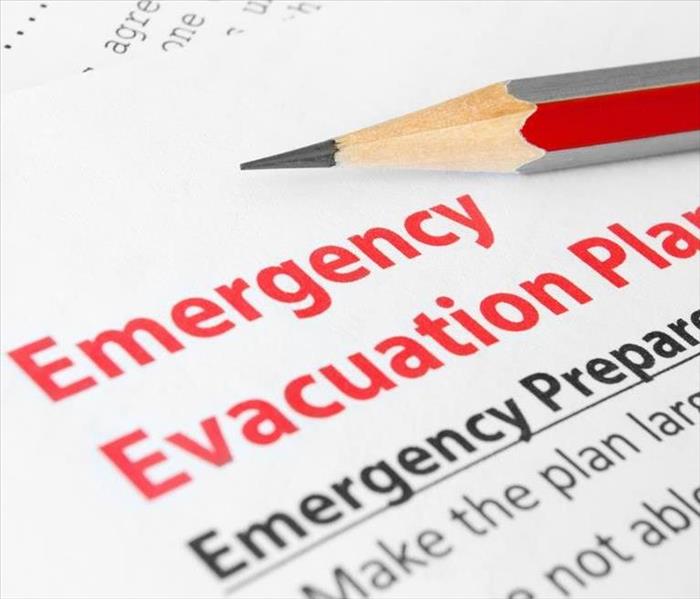 Having an emergency plan in place is essential to having a workplace prepared for an emergency.
Having an emergency plan in place is essential to having a workplace prepared for an emergency.
In any workplace, it is crucial to prioritize the safety of employees in the event of an emergency, such as a fire. Having a well-thought-out fire escape plan is essential to ensure the swift and safe evacuation of everyone in the office. In this blog post, we will guide you through the steps of creating an effective office fire escape plan to protect your employees and your business.
Assess the Office Layout
Start by thoroughly assessing the layout of your office space. Identify all possible exit routes, including doors, staircases, emergency exits, and windows. Take note of any potential obstacles or hazards that may impede the evacuation process, such as cluttered areas, furniture placements, or narrow pathways.
Designate one or more assembly points outside the office building where employees can gather and be accounted for after evacuating. Choose a location that is a safe distance away from the building and easily identifiable. Make sure the assembly points are communicated clearly in the fire escape plan and easily accessible for all employees.
Establish an Emergency Communication System
Set up an emergency communication system to effectively alert employees in case of a fire. This system could include fire alarms, intercoms, and megaphones installed throughout the office. Ensure that all employees are educated on recognizing the alarm signals and understand the appropriate response when they hear them.
Identify key personnel who will have specific roles and responsibilities during an evacuation. This may include floor wardens, marshals, or other designated individuals who will assist in guiding employees to safety. Clearly communicate these roles and responsibilities to the designated individuals and provide them with appropriate training, if necessary.
Educate and Train Employees
An effective fire escape plan is only as good as the people who understand and follow it. Conduct regular training sessions for all employees to familiarize them with the office fire escape plan. Review evacuation procedures, emergency exit routes, and safe practices during an evacuation. Provide employees with instructions on how to respond in different scenarios, such as evacuating through smoke-filled areas or assisting individuals with mobility issues.
Place clear and visible signage throughout the office that indicates evacuation routes, emergency exits, and assembly points. Ensure that these signs are strategically placed and easily understandable, even in high-stress situations. Regularly inspect and maintain these signs to ensure their visibility and accuracy.
Conduct Regular Drills
Practice makes perfect, and this is especially true when it comes to emergency situations. Conduct regular fire drills to test the effectiveness of your office fire escape plan and employees' understanding of their roles and responsibilities. During these drills, observe and provide feedback on their performance, offering any necessary guidance for improvement.
As your office layout or workforce changes, revisit and update your fire escape plan accordingly. Regularly review and evaluate the effectiveness of the plan, taking into account any feedback or incidents that may have occurred. Make adjustments as necessary to ensure that the plan remains up-to-date and aligned with best practices for workplace safety.
Communicate the Fire Escape Plan
Ensure that every employee is aware of the office fire escape plan by communicating it clearly and regularly. Conduct orientation sessions for new employees, provide written materials outlining the plan, and include it as part of your employee handbook. Foster a culture of safety and encourage open communication so that employees feel comfortable asking questions or seeking clarification about the fire escape plan.
Collaborate with the local fire department or emergency services to review your office fire escape plan. They can provide additional guidance and recommendations based on their expertise and experience. Their insights can help you refine and improve your plan, ensuring that it meets all safety requirements and is aligned with local regulations.
Creating an office fire escape plan is a critical step in ensuring the safety and well-being of your employees in the event of a fire. By following these steps and regularly reviewing and practicing your plan, your workplace will be better prepared to respond effectively in case of an emergency. Remember, a well-prepared workforce is your best defense against fire hazards, and investing in their safety should always be a top priority.
Fire Prevention in the Kitchen: Essential Cooking Tips to Reduce Hazards
4/28/2023 (Permalink)
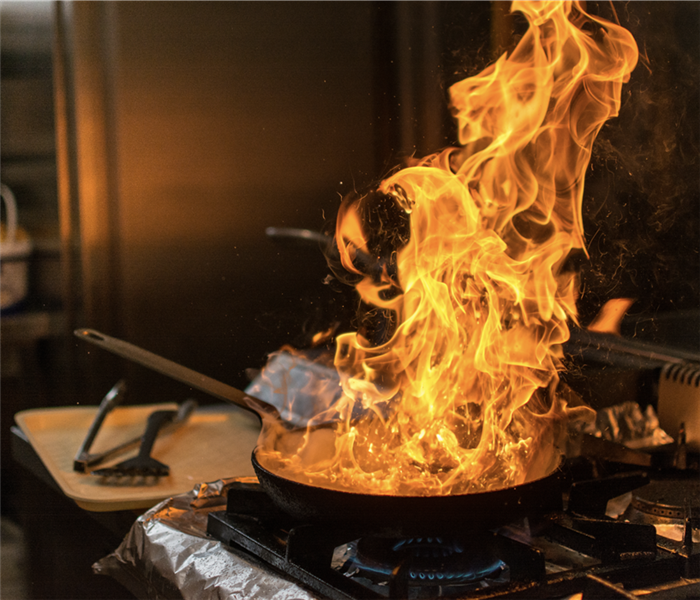 One of the most common causes of kitchen fires is leaving cooking unattended.
One of the most common causes of kitchen fires is leaving cooking unattended.
Cooking is an everyday activity that most of us engage in without thinking about the potential hazards. However, it is essential to be aware of the risks involved, especially when it comes to fire. A grease fire is a common kitchen hazard that can quickly escalate into a full-blown fire if not handled correctly. In this article, we will discuss some essential cooking tips to reduce the risk of fire in your kitchen.
Keep the cooking area clean
A clean kitchen is the first line of defense against fires. Grease buildup on surfaces and appliances can ignite and cause a fire. Therefore, it is important to clean your cooking area before and after each use. Make sure to wipe down the stove and oven, countertops, and any other surfaces that may have come into contact with grease or oil.
Never leave cooking unattended
One of the most common causes of kitchen fires is leaving cooking unattended. It is essential to keep a close eye on the food you are cooking and to never leave it unattended, especially if you are frying food. If you must leave the kitchen for any reason, turn off the stove or oven, or ask someone to keep an eye on the food for you.
Keep flammable objects away from the stove
Flammable objects such as kitchen towels, curtains, and even loose clothing should be kept away from the stove. If these objects come into contact with a hot surface or an open flame, they can quickly catch fire.
Don't overheat oil
Overheating oil is a common mistake that can lead to a grease fire. When oil reaches its smoke point, it can catch fire. Therefore, it is important to never overheat oil when cooking. If you notice the oil smoking, turn down the heat or remove the pan from the heat source.
Use the right type of oil
Different oils have different smoke points, which is the temperature at which they begin to smoke and can catch fire. When cooking, it is essential to use the right type of oil for the job. For high-heat cooking such as frying, it is best to use oils with a high smoke point, such as peanut or canola oil.
Keep a fire extinguisher nearby
Despite your best efforts to prevent fires, accidents can still happen. It is essential to keep a fire extinguisher in the kitchen and to know how to use it. Make sure the extinguisher is rated for kitchen fires, and that everyone in the household knows where it is located.
In conclusion, cooking is an essential part of our daily lives, but it is important to take precautions to prevent fires. By following these essential cooking tips, you can reduce the risk of fire in your kitchen and keep your home and family safe. Remember, a little bit of prevention can go a long way in avoiding disaster.
How Often Should You Clean Out Your Dryer Vent?
8/31/2022 (Permalink)
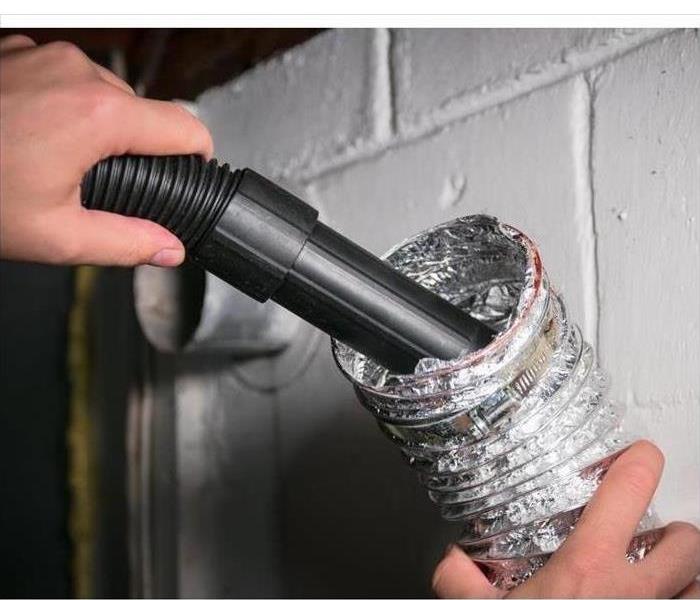 Vacuum out the vent carefully, going as far into the vent as you can
Vacuum out the vent carefully, going as far into the vent as you can
To avoid a lint fire in your clothes dryer, you must clean the lint filter after each use. The dryer vent should also be cleaned at least once a year to significantly reduce the risk of a dryer fire in your Greenwood Village, CO home.
Steps To Follow When Cleaning the Dryer Vent
It's important to mention that if you don't have a lot of mechanical ability or physical strength, you should have a professional do the job to avoid costly fire damage repairs.
- Unplug the dryer and carefully pull it away from the wall.
- There is a tube connecting your dryer with the dryer vent in the wall. Carefully disconnect the tube using a screwdriver. Different dryer models require different types of screwdrivers.
- Using your vacuum's nozzle attachment, vacuum out the vent carefully, going as far into the vent as you can. Thoroughly vacuum out the tube as well.
- Reattach all of the components and push the dryer back into place. Plug the dryer back into the wall socket.
Ways To Keep the Dryer Vent Clean
In addition to cleaning out the dryer vent each year, you can reduce the amount of dirt and lint that works its way into the vent by following a simple routine. This will also reduce the risk of a lint fire.
Keep the floor that surrounds the dryer clean. Sweep up lint and debris after each use.
Dryer sheets can coat the dryer vent, causing lint to build up more easily. You don't need to totally eliminate the use of dryer sheets, but try to limit using them on clothes that create the most static, such as wool socks and polyester materials.
Dry your clothes in the least amount of time needed to get them dry. Cycles of 30 to 40 minutes will allow for better air circulation than longer cycles.
Avoid a costly lint fire in your dryer by following these simple steps.
What Should I Throw Away After a Fire?
5/23/2022 (Permalink)
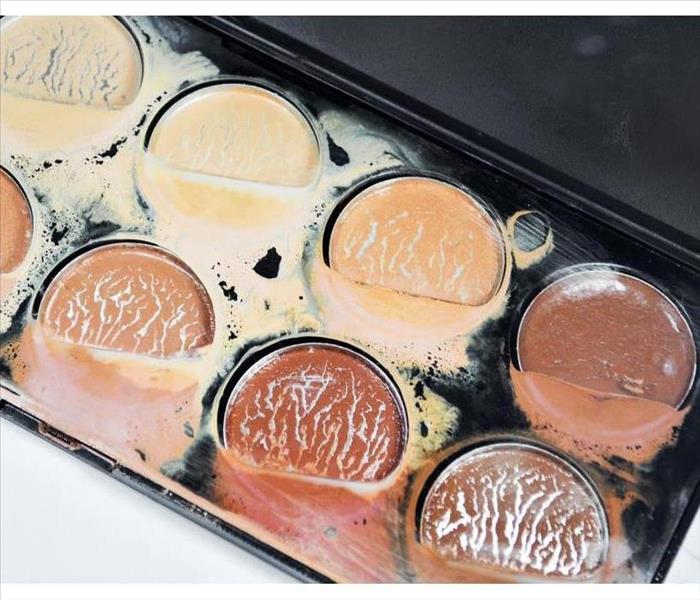 Cosmetics damaged by fire need to be discarded.
Cosmetics damaged by fire need to be discarded.
After a Fire, What Should I Throw Away?
After you've had a fire in your Greenwood Village, CO, home, many of your belongings can be damaged by smoke, water and heat. Some items may be obviously ruined, but you might be wondering whether to throw away other things that don't have visible signs of damage. You should still discard certain household items after a fire for safety reasons.
Room-Temperature Perishable Food
It's possible to save refrigerated food after a home fire. If the refrigerator stayed tightly closed and did not sustain fire damage, the food inside should be safe for about four hours without power.
Check inside an intact refrigerator and evaluate the condition of the interior. Discard any food that:
- Has a strange smell or color before or after preparation
- Was above 40 degrees for more than 2 hours
- Was frozen but no longer has ice crystals in it
- Has the smell or appearance of smoke
Damaged Nonperishable Food
While cans of food may remain intact after a fire, it's best to throw away anything that was near the flames. High heat can cause the food inside to spoil or taste bad, and fumes can penetrate sealed cans or glass containers. Any food with apparent signs of damage or exposure, like rusted and bulging cans or containers covered in extinguisher dust, should be discarded immediately.
Cosmetics and Medicine
It may be hard to discard expensive medications, but if they show any signs of fire damage, it's safest to get rid of them. Call your doctor right away if you need to replace prescription medication. Inspect cosmetic packages for signs of exposure to high heat, like warped packaging or a smoke smell.
A professional fire restoration company can help you sort your belongings and determine what is salvageable and what should be discarded. When it comes to consumable items, it's best to err on the side of caution when deciding what to throw away after a fire in Greenwood Village, CO.
Repairing Smoke-Damaged Contents
5/21/2022 (Permalink)
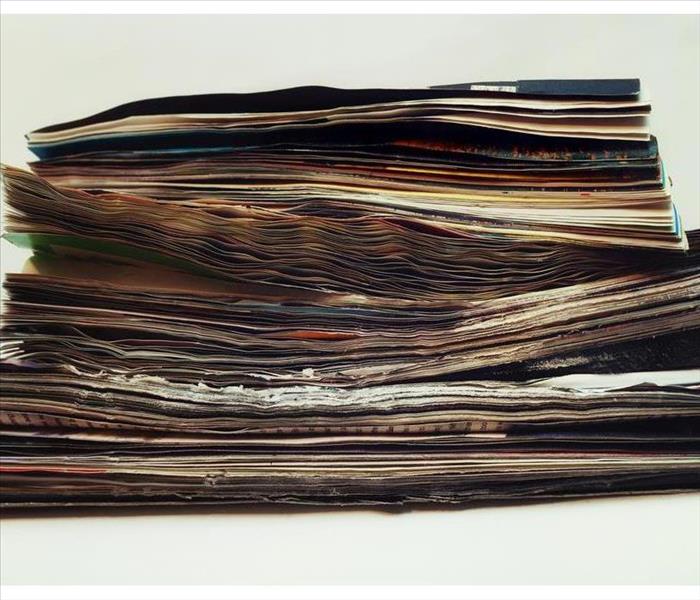 Business documents and other contents are very important for the survival of the business.
Business documents and other contents are very important for the survival of the business.
Content Cleaning After a Fire
If your Littleton, CO, business is damaged in a fire, you have more than the structure to worry about. Unfortunately, the materials in the building are also likely to be damaged. An experienced restoration service can help you with content cleaning and repair. Although dry-cleaning is one of the most common methods, there are a variety of options available.
Cleaning
Your business likely has a mix of porous and non-porous items that must be cleaned after a fire. Some items will be covered in soot, and others may have water damage from the extinguishing efforts. The specific approach should be tailored to the individual item, but some common techniques include:
- Dry-cleaning
- Abrasive cleaning
- Immersion cleaning
- Foam cleaning
The faster cleanup begins, the less likely the items are to suffer permanent damage. Mold growth can begin within 24 hours when an item is wet, so it is important to start the cleanup process as quickly as possible.
Repairing and Replacing
Unfortunately, dry-cleaning and other cleaning techniques are not enough for some items. These objects require more intensive restoration methods, such as replacing damaged parts and re-covering surfaces. Other items are not salvageable and must be replaced. Professionals can help you determine what can be repaired and what needs to be thrown away.
Storing
A good restoration company will provide content storage along with cleaning services. Storing items off-site allows more room at the building for big cleanup jobs and structural repairs. Climate-controlled storage is an ideal solution for the contents of your commercial building. Make sure you feel comfortable with the storage area before your belongings are moved. Ask about retrieval policies and what happens if your items are damaged at the storage location.
Business documents and other contents are very important for the survival of the business. If these items are damaged in a fire, the results can be catastrophic. Fortunately, the technology exists to restore many of these items to preloss condition.
Tips for Getting an Accurate Restoration Estimate
3/24/2022 (Permalink)
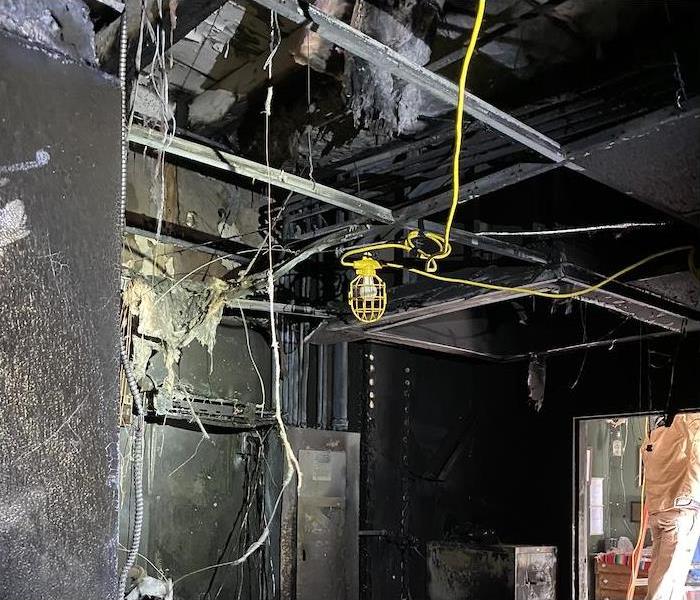 Severe fire damage in Englewood, CO.
Severe fire damage in Englewood, CO.
How to Get a Reliable Restoration Estimate
After your commercial building has been affected by fire, how much will it cost to have affected areas repaired and reconstructed? You need to act fast in obtaining fire damage restoration services if you want the best results. With this in mind, some of the most important things you can do are getting an estimate concerning reconstruction costs and contacting your insurance company.
Your First Course of Action
There are four steps to restoring your property after a commercial fire.
- Contact emergency professionals, from the fire department to fire damage remediation experts.
- Apply tarps to seal the holes in the roof or walls.
- Assess the extent of the damages throughout your property.
- Cleanup and rebuild the damaged building.
An estimate is generally provided during the assessment step. The detailed document should include all of the services and work expected. A coordinator will keep a file on the job, communicating with insurance professionals, and other officials who may be involved.
Work Closely With Project Managers
Most of the work in coming up with an estimated cost of recovery is completed by the damage remediation professionals, but there are some steps you can take to increase the accuracy of that approximation:
Keep clear records and store documents where they can be accessed easily.
Take pictures and write notes describing the damage.
Communicate often and clearly with remediation professionals.
Designate one person from your company to act as a liaison with all other professionals.
Project managers from the remediation company may contact you often to discuss what needs to be cleaned, removed, replaced, repaired, or completely rebuilt. These experts are the people most likely to provide the quotes you need to move forward with recovering from the fire.
Get Quotes Quickly
How much can you expect to pay when recovering from a commercial fire in Englewood, CO? For quick, accurate results, work closely with your insurance agents and your restoration company, maintain organized records, and keep clear lines of communication open.
What Happens During the Fire Cleanup Process
2/21/2022 (Permalink)
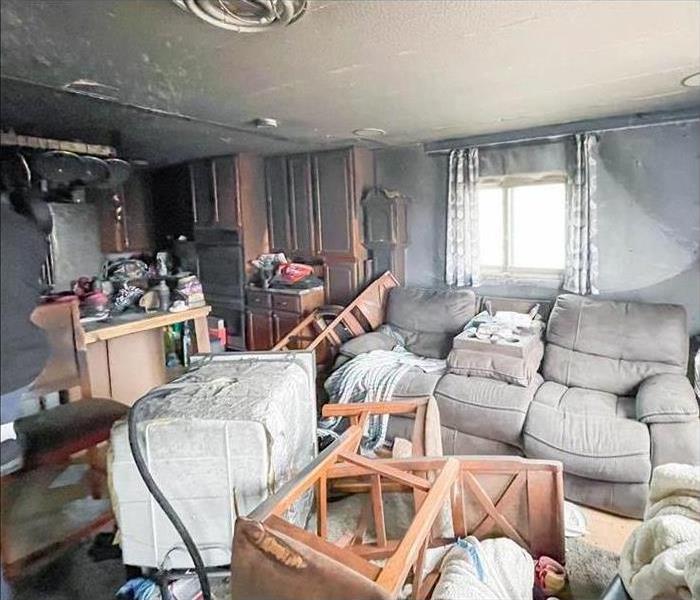 If you experience a fire or water loss, our team is always ready to go. 24/7, 365 days a year! Call SERVPRO, we are faster to any size disaster
If you experience a fire or water loss, our team is always ready to go. 24/7, 365 days a year! Call SERVPRO, we are faster to any size disaster
What Happens During the Fire Extinguishing Procedure?
If your Englewood, CO, home has been damaged by a fire, contacting a remediation service is a good idea. They can professionally remove fire and smoke damage from your home and help get everything back to the way it was before the incident. One crucial part of restoring your house is cleaning up your home and any damaged belongings.
1. Removing Soot From Your Home
The first part of the cleanup process will be removing any soot from your home. Soot consists of carbon particles that are created during a fire and will likely cover walls, floors and items near where the fire occurred. A fire restoration service will be able to clean and remove the soot damage from the structure of your home.
2. Cleaning Your Belongings
Some of your belongings may have fire damage that makes it difficult to save or restore them, but others might only have smoke damage that can be removed. Any items that can be salvaged will be cleaned during the restoration process to return them to the condition they were in before the fire.
3. Removing Smoke Odor From Your Home
Once all of the soot has been removed from the home and your belongings have been restored, smoke cleaning will be performed to remove any remaining odors. Smoke has a strong smell that can linger in your home after a fire, but fogging equipment and industrial air scrubbers can be used to get your home smelling clean again.
After a fire, it is important that you call a professional service to perform the cleanup process for you. Depending on the size of the fire, there can be quite a bit of smoke damage that can be difficult for you to remove on your own. A fire restoration company will have the proper training and equipment to return your home to its prior condition.


 24/7 Emergency Service
24/7 Emergency Service






